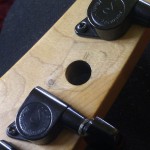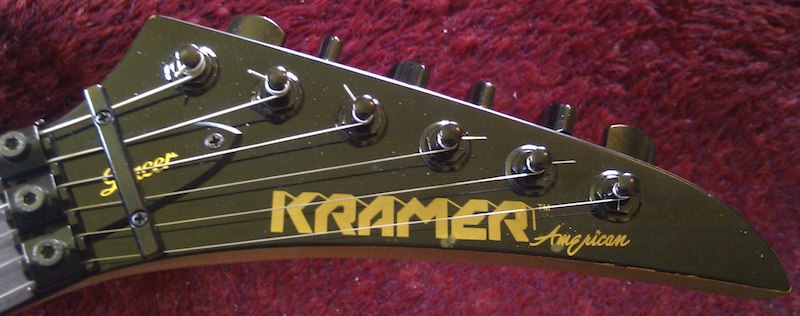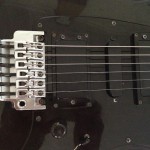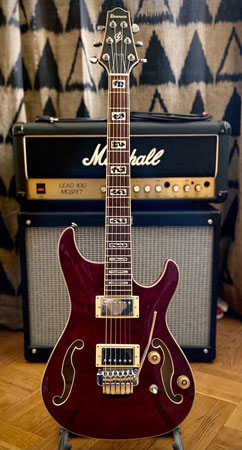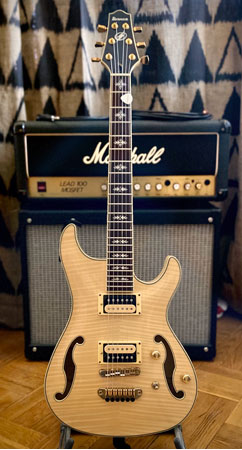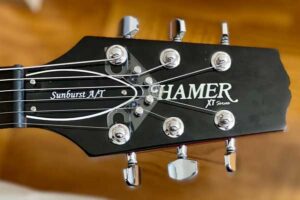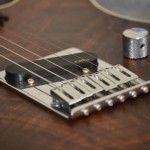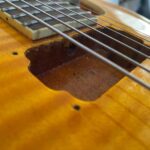Wahlberg (JaWa custom) Strat
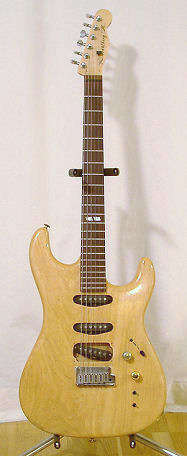
Built around 1991 by Stockholm based luthier Jack Wahlberg. Swamp ash body by Warmoth, quartersawn maple/rosewood neck by JaWa (strat heel, tele peghead) with Dunlop 6150 fret wire. The fretboard inlay at the 12th fret is real mother-of-pearl, taken from the thumb grip on Jack’s fathers’ violin bow. Jack thought it would give the neck a nice personal touch… The guitar was originally built around the late ‘80s Valley Arts/Tom Anderson ideal – tilted neck, gold Floyd Rose, ditto Gotoh tuners and Ultrasonic HSS pickups. Actually, to be honest I wanted it to feel like an ’86 Kramer Pacer I once owned, which is why it had the tilted neck instead of a recess for the Floyd.
Sometime around 1997 – a while after I had ditched my rack system in favour of a (now long gone) ’78 Fender Twin – I wanted to get more into raw woody strat sounds (the Floyd Rose together with the bright and snappy swamp ash body made the guitar a little on the thin side), so it was time for a rebuild. I bought a Fender American Standard bridge and got Jack to install it. He also glued in a piece of rosewood to make up the bit behind the nut and re-routed the neck pocket (to remove the tilt required by the non-recessed floyd) and filled the holes through the neck left by the floyd nut bolts. I also changed the pickups for a set of Lundgren ’60s Vintage single-coils (as seen in the pic). The humbucker rout was too tight for a single coil, but that was nothing a little chisel action couldn’t solve – hey, it’s my guitar… 🙂
I later tried a Tele bridge pickup, which required even more modifications to the route. This time I was able to Dremel out some wood below the top edge (leaving a lip so if I eventually were to fit a humbucker mounting ring it wouldn’t show up). Sure enough, by 2010, I’d gone back to a bridge humbucker (a Tom Anderson H2), and later installed a set of DiMarzios – two DP408 (Virtual Vintage 54 Pro) and a DP191F (Air Classic Bridge). At the same time, I re-did the electronics with a fresh 5-way switch and two Bourns pots. I went with 500K pots (since the H2 had felt too dull with the 250K pots that were in the guitar at that time), but of course things got too bright… It seems that the DiMarzio pickups work fine with 250K pots – even the Air Classic humbucker – so I tweaked the volume pot to lower its value. So now it has a 250K volume (288K to be precise :)) and a 500K tone. The pickups have since been changed again – I took the Fender Robert Cray neck and middle single coils and Harmonic Design Z-90 bridge pickup out of the Charvel (mentioned below) and stuck them in this one instead. The Dimarzios went into the Charvel.
This guitar is very bright and punchy in the upper-mid region, due to the construction. The neck isn’t secured with regular wood screws, like other strats. It actually has metal threaded collars sunk into the neck (underneath the fingerboard), and uses fine-threaded bolts to ensure a tight fit. It works like a dream, and as a result, this guitar has the most ”active” (as in vibrant) neck I’ve ever experienced. On top of that, the body is made from a very lightweight and resonant piece (two pieces, actually – the two parts are glued together right below the pickup routs) of swamp ash. Can you say ”TWANG”?
As with all my 25.5″ scale guitars, I’m running 010-046 strings, either GHS Boomers or Elixir Nanowebs.
mongrel strat – unknown origin

One day one of the staff at Estrad (now 4sound Folkungagatan Stockholm) showed me this guitar that had come in a trade deal – he was thinking about buying it, and wanted to show it to me. It had a crack in the body around one of the bridge screws that let the bridge flop around a bit, and IMO really crappy pickups. We both recognised its potential, and a problem arose: we had fallen in love with the same guitar… Later that day, I took a cheap shot and played the ”I’m the customer” card… apparently customers’ wishes supercede those of the staff. (Sorry, Leffe. Still friends?) Anyway, with that settled, Estrad’s then guitar tech Jörgen Bergerstedt – one of the best guitar techs, and nicest people, I’ve ever had the pleasure of meeting – fixed the crack with a piece of hardwood and set the guitar up. It played like a dream.
It has a standard replacement body (one you’d get from WD, Allparts, Chandler etc) with unknown body wood, and a birdseye maple telecaster neck. The pickguard I think has a “Chandler” sticker on it – but that’s the only identifiable part of the guitar… The pickups are Fender Texas Specials, with a Fralin Baseplate installed on the bridge pickup.
It’s a slightly strange guitar – its sound isn’t very well-defined in the upper mid region, but it sounds positively awesome with the Texas Specials in it. With fresh strings on it’s a killer guitar, but somehow the tone loses its body quicker than usual – like the strings die faster on it… One of these days, I might replace the bridge for a Wilkinson vintage-style unit, or a 6-screw Gotoh 510 with steel block.
Charvel/Warmoth strat
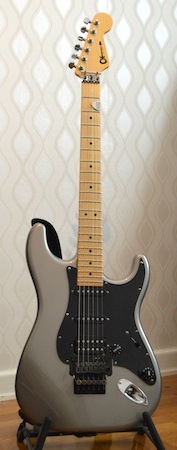
I had already bought and fixed up the ESP/LTD (below), and thus gotten back into Floyd Rose superstrats, when I spied this one for sale. It turned out the seller was a friend of mine (thanks LG!), who decided to sell it because he didn’t need too many Floyd/strat-style guitars. Not that I did either, having recently also bought the Kramer, but I decided to give it a go anyway…
It has a Warmoth body in swamp ash, painted in pewter (a semi-dark grey metallic) with a maple/maple Charvel Japan neck with Grover tuners (from a Pro Mod San Dimas) and an original Floyd Rose. It’s a really resonant and ”alive” guitar, which is just how I like them. As such, it quickly relegated the ESP/LTD to backup status. The pickups that came with the guitar (Fender Robert Cray neck/middle single coils and a Harmonic Design Z-90 [P-90 in a humbucker-sized housing]) went into the Wahlberg, while the Dimarzios I took out of that guitar went into this one. So now it has the same pickup configuration as the ESP/LTD below (Virtual Vintage 54Pro for neck/middle and an Air Classic in the bridge).
I really like the neck – it’s not Ibanez thin, but no boatneck either. It’s a hair slimmer and wider than the ’60s style ”C” Fender necks I normally go for, which really fits my hand. And the frets are most definitely jumbo – if I were to guess, I’d say the Dunlop 6105 fretwire comes closest. It’s a fast neck, no doubt. I like it so much that I’ve actually bought another just like it. I figured it might come in handy some time… 🙂
1986 Ibanez Roadstar II RG420/440
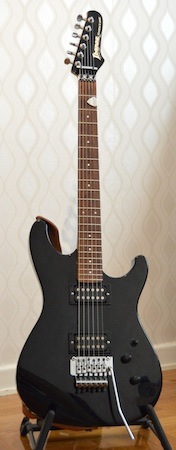
On a whim I bought a 1986 Ibanez RG420 Roadstar body off eBay. It’s made from basswood (which contrasts quite nicely with the swamp ash-bodied guitars I’m used to), jet black with two humbuckers and routed for an Ibanez Edge (licensed Floyd Rose). I had the idea of creating a humbucker-equipped alternative with the slightly drier basswood timbre. I then ordered a Charvel San Dimas neck (same as on the Warmoth/Charvel) for it, but then – not long after finding the completely original RG450 mentioned elsewhere – I came across a 1986 Roadstar neck, with black headstock. Finding one of those isn’t as easy as it may seem – it has to be a 1986 model (since that was the only year they had the original Edge (Floyd Rose licensed) tremolo/locking nut on the older style necks. And when you do find one, the headstock is usually the wrong colour. So this one had my name all over it 🙂
The neck came off an RG440 (the HSS model), but the necks were the same across the 1986 RG4xx guitars, so it fit right in. I’ve polished the frets and cleaned/oiled the fingerboard, and that’s it. I needed a bridge for it – ideally it should be a chrome original Ibanez Edge, but those are getting expensive. I’m currently using a chrome Gotoh floyd (w/ 40mm block) that I originally used on the ESP/LTD. The Gotoh and Ibanez Edge are quite similar both in appearance and feel, so it works ok. Pickups are from Tom Anderson – a H1- in the neck position and H2 at the bridge.
ESP/LTD ST-203FR

I got this one cheap when my local store had a sale. It’s cheap even at normal price, but this deal was too good to pass up. Now, I keep reading on the web that the ”reliced” paint is actually a decal applied to the wood, on which the clear coat is then applied. I know better than to take everything I read on the internet as gospel, but different examples of this model do look suspiciously similar…
The stock pickups and electronics of course reflected the guitar’s purchase price, and didn’t last. I went for Dimarzio Virtual Vintage 54 Pro’s in the neck and middle position, with an Air Classic bridge humbucker. The stock 5-way switch felt really flimsy and was a bit intermittent in the middle position, so it was replaced for an Oak switch with a Callaham ’60s style switch knob (I very much prefer the stubby kind over the tall/pointy switch tips used on most Far Eastern guitars). I also moved the volume knob up to the stock Fender strat position (that’s what I’m used to, after all) and changed the volume pot value to 250K, to better fit the new pickups.
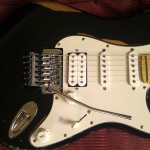
The bridge that came with the guitar was a Floyd Rose Special, which was no good at all. It looks and functions like an original Floyd Rose, but the bridge plate and block is made from zinc rather than steel. Basically, it didn’t stay in tune, and strings kept slipping out of the bridge. I threw in a Gotoh floyd – as shown in the pictures – and it worked well, aside from the trem block being slightly too deep (at 40mm) for the guitar. That tremolo eventually ended up in the Ibanez RG420 (further up the page), which doesn’t have a recess for the tremolo, so the block actually fits inside the cavity. Since then, Gotoh has released a version with a slightly shorter block (36mm), so I might go for one of those for this one. In the mean time, the guitar has a black original Floyd Rose that I had in a drawer.
All in all, it’s a cheap and cheerful guitar, which actually swings quite a bit above its weight. As HSS-equipped floyd (locking trem) style superstrats go, it absolutely holds its own. Once you replace the pickups, pots and switch, and bridge that is… at which point it may not feel quite as cheap anymore 😀 Then again, an equivalent full-on ESP would cost at least 5 times as much as I have invested in this one, so…
1986 Kramer Pacer Custom 1

If you’ve checked out the History page, you know that I bought one of these brand new back in 1986/87 and sold it a couple of years later. I’ve regretted selling it ever since, and have often wondered what happened to it. Mine is easy to identify, as the neck heel has been cut down – it wasn’t made thinner, as is often done these days, but we simply cut off a corner to gain more access to the top of the fretboard. One day – 20+ years later – I spotted a ”for sale” ad for one of these, and by the picture it looked like it actually could be my old flame… it was pearl white, with the ”pointy droopy” head and block logo (which was only used in 1986, before they switched to the ”diminishing” logo). It turned out that it wasn’t my old guitar, but I ended up buying it anyway. It was shipped to me, and opening the case and picking it up was like an instant time machine… I remembered exactly what I was going for when I ordered the Wahlberg 🙂
Aside from the output jack (the one that came in the guitar obviously had been replaced, and I quickly replaced that one with the correct type), the guitar is completely original and only seems to have a few dings and scrapes. The colour is pearl white – think of it as white with a slight reddish/pink hue that comes out at certain angles, while in some angles and light conditions it turns mint green/parchment. It used to have a Tremsetter, but it has been removed at some point (I don’t remember if my original guitar had that contraption – if it did, I must have removed it too, as I used to pull the bridge quite far back :)).
The factory had installed one of the tuning pegs a little wonky, so it was tilted a tad forward. I quickly took it off and filled the hole with toothpicks and super glue. A sharp knife later, the hole was effectively gone, and I could then drill a new pilot hole in the correct location.
The bridge pickup is a Seymour Duncan JB (marked ”JBJ”, which I’ve found out means it was wound by Maricela Juarez), while the neck and middle pickups are Seymour Duncan APS-1 single coils. The guitar has three micro switches (on/off for the two single coils, and split/off/series for the humbucker), as well as a fourth switch that selects the bridge pickup in series mode. The sole volume control is a 500K pot with a treble bleed capacitor, which makes the single coils very bright. When I received the guitar, the bridge pickup wasn’t correctly wired, so I ended up re-doing most of the internal wiring to bring it back to original specs. I did disconnect the treble bleed capacitor, though, and lowered the volume pot value to about 300K to take a little edge off the single coils. It did however make the humbucker a bit too dull… So I’m trying another approach – I’m going to put the pot back to 500K and reconnect the capacitor (to help the humbucker breathe a bit), while adding resistors to the single coils to simulate a 250K pot when they’re in use.
Yes, I know that pointy head guitars are a bit naff, but this one is actually really good. And to me, it’s just like coming home – even though Kramer were notorious for having changing neck profiles etc during the ’80s, this one is just like I remember mine. The frets are a fair bit lower than I remember (or would prefer) – most likely, someone has had them re-crowned at some point. But other than that it’s great. Of course, I’ll still keep an eye out for my old one too. It can’t hurt to have two, right? 😀
1986 Ibanez Roadstar II RG450
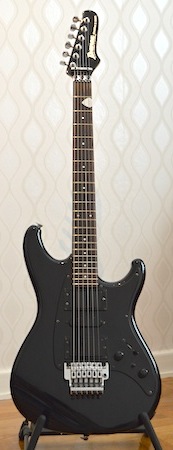
Yup, another trip down memory lane… I used to lust for these guitars back in the day, and some 27 years later I found one for cheap right here in Sweden. It came all complete, except for the case and tremolo arm, in really good shape with stock pickups, untouched wiring and all.
Manufactured in May 1986 at the FujiGen Gakki plant in Japan, this RG450 was part of the Roadstar Deluxe series. 1986 was the last year of the old-style Roadstars, but also the first year of the Edge tremolo (licensed from Floyd Rose), which by many is considered one of the best Floyd Rose-style tremolos ever. I tend to agree…
The 450 came with two IBZ humbuckers and a Super 7F single coil in the middle position, and for some strange reason Ibanez chose not to hang the humbuckers from the pickguard as you’d normally do. Instead, they used pickup surrounds, which screw through the pickguard and into the body. So that’s 8 more screws holding the pickguard in place, and when you lift the thing out to do some soldering work, the humbuckers need to be taped to the pickguard to stop them falling out of their holes… Annoying stuff.
Anyway, I gave the guitar a quick once-over – which didn’t take long, considering the great shape it already was in (just look at that bridge!) – cleaning the guitar up, polishing the frets and adding some lemon oil to the fretboard, the guitar both looked and played really well. There’s even plenty of fret life left. Plugged in, the guitar sounds really good – the pickups are maybe a bit bland, but better than I remember from back then. I have sourced a new tremolo arm (Ibanez still makes them) and found an original case for it. So now it is complete.
I am in two minds about the guitar – one the one hand, I want to keep it completely original, just because it is such a mint example. On the other, I’d love to tweak it into something that I can use. I am toying with having a new pickguard made for it, so I can install new pickups and electronics while keeping the original setup completely original. A tortoise guard might look nice…
1987 Ibanez RG440

I mentioned earlier that 1986 was the first year with the Edge tremolo and the last year with the old style headstook. This is another transitional piece, it seems. It has the pointy style head (flat rather than angled), and while the neck shape is thinner than the 1986 ones, it is still a fair bit thicker and more rounded than the later necks – I’d say it’s somewhere between the 1986 shape and the newer ones introduced with the JEM777 (in 1987) and the following RG series (from 1988 onwards). It also has a different pickguard shape (more strat-inspired) than the earlier Roadstars, making it quite easy to identify as a 1987 model.
The guitar was manufactured at the FujiGen Gakki factory in Japan, in april 1987.
I came across this one for cheap, and took a gamble thinking that if it was completely shot, I could always part it out and make the money back. As it turns out, it’s definitely in salvageable condition, and will probably get played instead. The ”duo-tone” push-push tone control is busted, and will need to be replaced, but otherwise it’s all there. The pickups are not original, but were a nice surprise anyway – it came with a set of Tom Andersons (from neck to bridge: SL1/SL1R/H2+). Not a bad find for a guitar bought on the cheap! Pics will be up when I get around to taking some, but for now you may enjoy a crop-out from the 1987 Ibanez catalog. In real life, the edges are a shade more purple than the picture suggests, but as ’80s colour schemes go, the Deep Wine is still fairly low key 🙂
Ibanez Artcore AS93
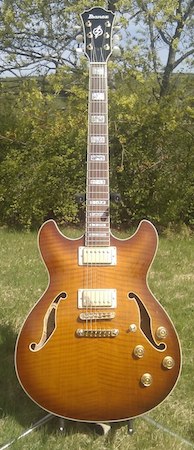
Recently, I have started gravitating more and more towards humbucker tones, and also started lusting for a semi-acoustic guitar. So when this one turned up relatively cheaply in the classifieds, I went into the deep end. For the price, it’s a really good guitar – way above other semis in the same price bracket. The stock pickups are a bit harsh at times, but replacing them is such a chore (with semis, you have to take the whole wiring harness out through the f-hole) that I may decide to save that job for a better guitar…
It’s funny how moving to a different type of guitar affects your playing – I find myself playing completely different lines, in a completely different manner, on this guitar than I do on one of my strats. And there’s something very special about the tone of a semi – there’s a nice ”space” around each note that you just don’t get with a solid guitar.
Like any other guitar of this type (with a Tune-O-Matic type bridge, actually), the neck is set at an angle in relation to the body. But on this one, the neck sits quite a bit higher than it should need to. It’s not that the angle is more acute, as the bridge doesn’t sit unusually high. The whole neck just sits a little high, and the carved top has a distinct dip around the neck pickup, which makes it look like it’s higher still. That said, the dip is there on the Gibson ES-335 too. The bridge doesn’t sit unusually high, though. I guess it’s a combination of the neck angle, the neck position (how deep it sits) and how much (or not) the top drops off in the bridge area. Anyway, this is not really a problem – once I’d set the guitar up, it played perfectly, so the guitar was obviously built this way. It just looks a little… well… cheap. Then again, it was cheap, so I can’t really complain…
The guitar is strung with 011-049 Elixir Nanowebs. If I were to improve anything, it’d probably be the pickups and electronics. But knowing how involved a pickup change is on a semi-hollow, time will tell.
Ibanez Artcore AWD82T
Another cheap Ibanez semi-acoustic, this time in a sort of strat-shape with a tremolo. This guitar was made in China in november 2004 and has a laminated bubinga top with laminated maple sides and back and possibly a mahogany center block (it is at least a brown-ish wood, but it of course doesn’t have to be proper mahogany). The neck is a three piece mahogany/maple/mahogany job (the three pieces are of roughly the same width, with the maple in the middle) and a rosewood fretboard.
It is a center block design with 24.75″ scale length and 12″ radius fingerboard. The neck is medium – probably thick for an Ibanez, but medium for the rest of us 🙂 – and quite comfy. The pickups are the same ACH-1 and ACH-2 as in the AS93, and like with that guitar, I’m not too keen on them. Changing pickups in a semi is a royal pain, but for some reason, this one seems slightly less so to me. It’s probably just due to the fact that there are less parts to mess with here 🙂
I have to say something about the tremolo too – it’s called the Ibanez ACT, and is specially designed for center block semis. The springs are much shorter and fit underneath the bridge itself, so you don’t have to rout out a big cavity in the back for them. It is a neat design, but inititally I didn’t get to try it out much, since the tremolo bar was missing when I bought the guitar. I started looking online, and quickly found out the part number. I also quickly found out that the only places that sold these wanted insane amounts (shipping included) for them. Then my local music store (4sound Uppsala – now sadly defunct) placed a quick call to the excellent Swedish Ibanez importer Crafton, who quickly found one in their parts bin. Internet doesn’t always win… Anyway, as I suspected, the tremolo lends itself more towards Bigsby-ish slight warble than divebombing, and as usual the G string tends to snag up at the nut. So maybe I’ll end up with a Graphtec nut, String Butler and locking tuners on this one too (like on the Hamer). Or maybe not – see below, as an example of what can happen when one gets something to compare it to… 🙂
Ibanez Artcore AWD102NT
As mentioned above, I had been thinking about replacing the pickups in the AWD82T, but kept putting it off because of the work involved in replacing pickups in a semi. But in my head, I saw a set of zebra Dimarzio 36th Anniversary PAF’s in there (most likely because that’s what was in the AWD I saw and heard in a video posted by Ibanez and DiMarzio guru Magnus Olsson, which was what drew me to the AWD series in the first place). Then out of the blue, I saw an AWD102NT up for sale, with DiMarzio PAF36’s in zebra… it must have been meant to be. And as it happens, the guitar did once belong to the aforementioned Magnus Olsson. It’s not the same one I saw in the video (that was a blue AWD82/83), but still… it’s a small world!
The guitar has a laminated flame maple top, back and sides, with a center block of unknown wood type. All I know is that it is fairly light in colour, pointing in the alder/ash/basswood direction. This time, the neck is a five-piece maple/bubinga affair – two thin strips of bubinga sandwiched by maple – with a rosewood fretboard. And no tremolo this time – this one has an ART-1 bridge with the Quick Change Ultra tailpiece (with fine tuners, which I don’t use). And not only does it come with PAF 36’s – the pots have been replaced for full-size ones, and it has Gotoh SG361 locking tuners. Basically the mods I was thinking about for the AWD82T…
The guitar did need a little TLC, so I did a quick cleanup, polished the frets and gave the fretboard some oil, and then slapped some fresh strings on it and did an equally quick setup. And the guitar plays and sounds amazing! It is both snappy, resonant and full-sounding at the same time. And therein lies the problem, for the AWD82T… having played this one, the more dull and boxy character of the 82T suddenly became painfully obvious. Sure, a set of good pickups and some locking tuners would probably help it, but I’m no longer sure it’d be worth the effort. The AWD102NT, however, is a right good one. So thanks to the excellent Kristian Niemann for the sale!
Hamer Sunburst Flametop
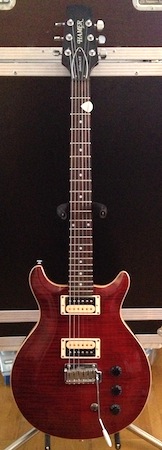
This one is from the XT series, so it’s one of the cheap ones – a ”real” Hamer Studio Archtop would cost ten times as much as this one did. It has a mahogany body with a cream bound flame maple top and mahogany neck. It is surprisingly heavy for its size, and while it balances ok when standing up, when sitting down the guitar body is constantly pulling itself to the right and towards the floor. I would love the guitar to be chambered, both for weight and tone purposes, but I’m not too keen on the idea of removing the top to do the routing 🙂 The Wilkinson tremolo itself works just fine, but the stock nut kept pinching the D and G strings, pulling them sharp whenever the tremolo was used. I replaced the nut for a Graphtec Black Tusc XL, which fit right in after a little sanding to get the height right. Its shallower slots helped the guitar stay reasonably in tune. But since the headstock wasn’t designed to let the strings run straight to the tuners (look at a PRS, and you’ll see what I mean), the D and G strings have a quite marked sideways pull. I looked far and wide for some roller string guides that work ”sideways” (for lack of a better term), which would make the D and G strings run in a straight line over the nut.
Eventually, I found the String Butler V3 from Dietrich Parts in Germany. I bought the acrylic version, thinking it’d help make it less visible (on this guitar, it would otherwise cover part of the logo). But in hindsight, I should have bought the all black aluminium version instead. While the acrylic version was easy to adapt to the truss rod cover (I had to sand it ever so slightly), it kept lifting off the surface of the headstock. And one of the ”forks” that go underneath the washers on the high and low E tuners broke off… The unit comes with pre-drilled holes (meant to be used on guitars with older style press-fit bushings, so I ended up using those to hold the thing down. I sharpied the screw heads black, but will replace them with proper black ones eventually. Anyway, the String Butler does the job it was designed to do – to keep the strings in a straight line across the nut – but I’d recommend getting the aluminium version and adapting the truss rod cover (if needed) instead.
The guitar has a set of Dimarzio 36th Anniversary PAFs, and while at it I also replaced the pickup surrounds for cream items. I’ve also rewired the controls – even though I could see the benefit of being able to adjust the timbre of the middle position, having separate volume controls nearly drove me nuts. I kept reaching for the closest pot (which controlled the neck pickup), thinking it’d turn the volume off. Not so nice when you’re on the bridge pickup with raging distortion… Now the first pot (closest to the picking hand) is a master volume, while the middle pot is disconnected. I’m thinking of turning it into a variable split control for the neck pickup – the modding bug keeps itching… 🙂 The guitar is strung with 010-046 Elixir Nanowebs.
So is the Hamer XT series any good? Well, for the money, it could well be argued that they are. This example, though, has some issues. The entire tremolo back cavity (where the springs go) is crooked, so the springs don’t line up properly with the cavity and the tremolo block just about touches wood where it shouldn’t. But the strings line up with the fretboard, which I suppose is the most important bit. Still, were I to buy another, I’d skip the tremolo version and just go for one of the regular stoptail models.
Warmoth Telecaster
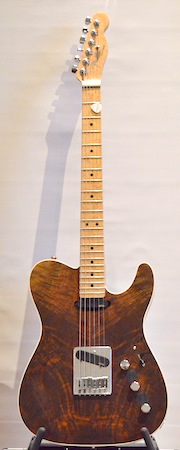
One time, I put a candy apple red Tokai strat up for sale, since I really needed the cash (and besides, I wasn’t really using it anyway). Naturally, instead of people lining up to buy the guitar, I got a trade offer I couldn’t refuse… This is a Warmoth Telecaster (despite the Fender logo on the headstook), sporting an alder body with an oiled walnut top. The neck is Warmoth’s standard thin shape, which is basically a sleek ’63 strat C-shape. The compound radius (10″ at the nut, gradually increasing to 16″) fretboard has Dunlop 6150 frets, and the whole neck is made from birdseye maple. It also has the Gotoh side-adjuster – a fine-tuner for the truss rod, so you can adjust the neck without taking it off. The bridge is a beefy Gotoh flat (yes! no ashtray!) six-saddle version, and the tuners are locking Schallers.
The guitar is currently sporting an EMG T-Set (alnico) with volume, tone and SPC presence (mid boost) control and a three-way switch mounted in strat-style fashion. For some reason, I’ve always wanted to try the EMG Tele pickups. Don’t ask me why, but now I have, and they’re quite good! The SPC control lets me dial in some midrange honk when I want to, and the tone control works beautifully to adjust the very top end. I often run it with the SPC just barely on, and the tone rolled off just a touch.
One thing about the EMG’s – if your Telecaster has a pickguard, it probably also has a relatively large neck pickup rout. My guitar, though, is top routed, and the pocket for the neck pickup is just large enough for a regular Telecaster neck pickup, and the EMG one didn’t quite fit. I ended up widening the rout a tad, and also (very carefully) grinding a little off the pickup’s edges as well.
Fender Special Edition Custom Telecaster FMT HH
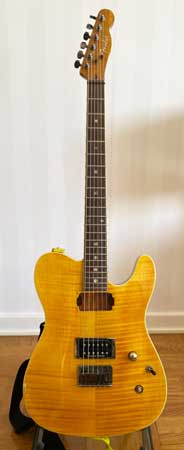
Catchy name, isn’t it? 😀 I found this one in ”project” condition, and couldn’t resist. I want to play Les Paul-type guitars, but every time I try (or buy) one, I remember I have a hard time getting along with the shorter scale length. I am a Fender player at heart, after all. So on paper, this one looked like just the ticket for me. It is a bit of an oddball as Telecasters go: a carved mahogany/flame maple body with a mahogany set neck and dual humbuckers, but with 25 1/2″ scale and Telecaster shape.
Fender are apparently making these again, but this particular specimen is a 2012 model, which has seen better days. The neck pickup is missing and there was gaffer’s tape residue all over the body. But as a project, it’s just fine.
According to the Fender spec sheet, the guitar should have Seymour Duncan Pearly Gates and ’59 bridge/neck pickups, with a push/pull split function on one of the pots. However, the seller mentioned the bridge pickup probably is a JB, while the missing neck pickup probably was a Jazz model. I have since verified that the bridge pickups was indeed a Pearly Gates, but there is no push/pull switch in this guitar, so there are obviously some things different compared to the spec sheet. The electronics had been worked on, but I can’t say if it is just remnants from when the neck pickup was pulled, or if anything has been replaced.
I quickly discovered that while Fender describe it as having a ”mahogany body with carved flame maple top”, that is a bit of a stretch. The body is actually three-piece mahogany (nothing wrong with that, mind you) which has been carved and then had a super thin flame maple veneer glued on to it. I can’t say I’m surprised, even though it would have been nice if the construction had been be a little more ”true” Les Paul, with a proper carved maple top. Another interesting thing is the weight, as this guitar is quite a bit lighter than expected. This is of course partly due to the maple veneer (rather than maple top), but also because of the carving. The guitar is more or less standard Telecaster thickness in the center, and a fair bit thinner around the edges.
The neck joint is nice, though – much more contoured than either a traditional Fender Telecaster neck heel or a Les Paul one. And the neck is a – for me – very familiar and comfortable traditional ”C” shape, with jumbo frets on a bound fingerboard. While the neck shape (and scale length) is pure Fender, the 15.75″ fingerboard radius veers clearly into Gibson territory.
I’ve started fixing it up, and so far I have installed a set of Tonerider Alnico 2 humbuckers, new pots with 50’s wiring and a new output jack, cream pickup rings and switch tip and chrome knobs. I’m also not 100% onboard with the black chrome hardware, and the bridge will probably be replaced for a chrome version with brass saddles. But for now the stock bridge and tuners will stay.
Epiphone Les Paul baritone
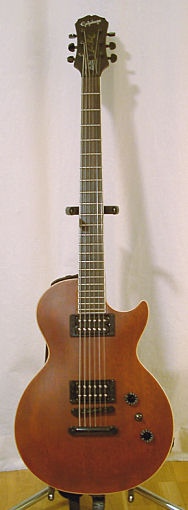
I ordered this guitar from an online retailer in Germany, having only seen the pics and read a review in Guitarist magazine. It turned out to be so cheap (it’s a Korean Epiphone, after all) that I figured I’d be easily able to sell it and recover my costs if I ended up not liking it. But I did have a hunch it was going to be good – you can’t really judge it by the quality of Epi’s regular Les Paul copies, since it is a completely different instrument. But I still wasn’t prepared for exactly how good it would be… It’s a 27.75″ scale Les Paul (yup, a full three inches longer than a regular LP…), with a mahogany body and carved maple top, stained brown with a matte satin finish. The set neck is maple – which hopefully will be a little sturdier than the more common mahogany necks – with a rosewood fretboard. The guitar is tuned B-B at the moment, and sounds absolutely gorgeous!
A baritone is really a completely different instrument, compared to a regular scale guitar, so you need to re-evaluate your playing to figure out what sounds good and what doesn’t. But at the same time… at first, everything you play sounds dead cool! Since the guitar uses a combination of longer scale and thicker strings to get to the halfway house between the guitar and bass that it is, it has that ”piano” type of quality on the low strings. Anyone who has tried slapping thicker strings on a regular guitar and tuning it low (or who have tried a regular scale 7-string, for that matter) knows that rubbery feeling from the strings. This is exactly the opposite… I initially had it strung 14-18-26w-44w-56w-68w, which I really liked. I’ve since tried the Elixir Nanoweb Baritone set, but the gauges (12-16-22p-38w-52w-68w) and especially the plain third string feels a little too loose for me. Even so, this is a guitar I will use sparingly, and the long-lasting Elixirs work great for that, so for the moment they are staying on.
The finish does have a couple of rough spots where a few dust speckles seems to have landed right before the satin finish dried, and the neck binding doesn’t feel 100% smooth all the way along the neck. But other than that, it is a very nice instrument. The Grover tuners do their job well, and work just fine without slipping or feeling overly sloppy. I was pleasantly surprised to find the control cavity painted with conductive paint, which extended up over the edge (to meet the foil on the inside of the control cavity cover) – a nice touch you sometimes won’t even find on guitars costing three times as much as this.
As always, the pickups are the weak spot. At least for me, who mainly play this guitar clean/clean-ish, the stock pickups are way too powerful. For now, I have (guerilla-style) wired the neck pickup for single-coil operation. I managed to pull the series connection (the point where the two coils connect) out and soldered it directly to the bottom plate, to ground it – instant single coil! But with the style I tend to play it, I’d really prefer being able to use the bridge pickup a bit more. I’m eyeing a pair of Dimarzio Bluesbuckers or EJ Customs. Time will tell…
Daisy Rock Retro-H 12ST
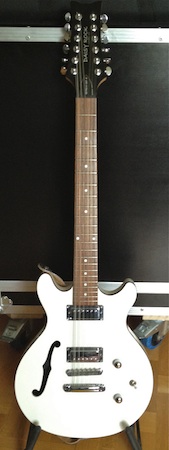
Yes, I know these are supposed to be for girls. But I don’t care – it’s just such a cool guitar! I got this one from 4sound in Karlstad, when Harry made me an offer I couldn’t refuse (thanks!). Basically it is a 24.75″ scale 12-string guitar with mini-humbuckers (or Firebird pickups – the stock ones definitely look like Firebirds, but I don’t know if they are constructed the same as those, or if they are ”regular” mini-humbuckers inside). I would definitely have preferred a 25.5″ scale, to keep the strings (currently D’addario EXL150) a little more taut. But beggars can’t be choosers, so… Anyway, the string pairs are grouped together rather tightly, so if you have fat fingers you might not like it. The tuners are from Grover, which helps a lot – tuning a 12-string can be a nightmare if the tuners aren’t up to the job. Obviously, the 12 tuners does make the guitar a bit neck-heavy when you wear it on a strap, but that comes with the territory, I suppose.
The control cavity is neatly wired and shielded with conductive paint and foil on the inside of the plastic cover, and all the wires are shielded as well. According to the specs on the Daisy Rock website, the guitar should have a push-pull function in the tone knob to allow for coil-splitting. This one doesn’t have that feature, which is a shame since I found the stock pickups to be slightly too dark for my taste. I quickly ordered a matched set of GFS ”Lil Crunchy” mini-humbuckers and wired them in parallel (for a brighter, more single coil-ish tone). That works great, although I am pondering rewiring at least the bridge pickup to series mode for a little more body to the tone. I mostly use it on the bridge pickup, for that bright, jangly tone that really brings out the octave strings. It’s not a guitar that sees much use, but it is a nice tone to have in your palette. 🙂
Squier Classic Vibe Jazz Bass

When they first arrived, I started hearing a lot of buzz about the Squier Classic Vibe line of guitars and basses. I decided to check them out, and rather than bringing another strat home, I walked out of the store with this one. It plays just perfectly, and was dead cheap. Simply awesome – it takes me back to the early ’80s, when the JV Squires were far better instruments than their Fender counterparts. The Classic Vibe Telecaster and Stratocaster are just as good, so get them while they are still allowed to make them this good!
I traded my Yamaha BB-414 (from the current production line, not the ’80s models, mind you) for it, and didn’t have to add that much in between, so for me it was a no-brainer. The Yamaha was not bad – especially after replacing the stock bridge with a Badass II – but it was no match to the Squier. It feels really weird saying that, but it really is that good! Everything about the guitar just feels better – it plays better, with more relaxed string height. I might replace the pickups, although the stock ones sound just fine to my ears. I also may need to work a little on the shielding – it is quiet enough with both pickups on, but as soon as I let go of the strings, it’s buzz city…
Still, as an instrument it is far, far better than the price would have you believe. Just to put in into perspective – when I bought it, I tested it against a couple of USA Fender Jazz basses at the store, and to my ears, the Squire not only held its own – I actually preferred it to the more expensive instruments! It seemed to be much more responsive, and felt much more ”alive”. Of all the basses in the store, the only one I preferred over the Squier was a sunburst ESP Vintage-4, but that was almost 5 times the money…
I normally use the bass with my Fender Bassman head and a cab (I’m preferential to the EBS Classic Line 1×12″, which works perfectly with the relatively low-powered Bassman), and a small pedalboard (featuring a tuner, EBS MultiComp and Octabass pedals, and a DOD envelope filter) on the floor. I will occasionally also use a Stinkfoot SD-1 Bass Drive overdrive pedal, if I need more dirt. I’ve also gigged with the 11 Rack (the expansion pack contains an Ampeg model with 8×10″ cab), which works great too, assuming the PA is big enough to carry the low end. I immediately took the finger rest off the bass (I can’t see the point of having it in that position), and that’s the only mod I’ve done to it so far. Strings are 045-105, GHS Boomers or EBS.
J&D JB5 5-string Jazz Bass

Yes, another cheapo… 🙂 I was investigating 5-string basses, and a good friend mentioned he’d bought one of these as a starter 5-string. Only a few days later, I spotted this one (used, but in great shape) for cheap… The basic instrument (alder body, maple/rosewood neck) is just fine, and I really like the slim ”C” neck shape. The hardware could be better, though. Everything works, but the pickups will definitely have to go. They are the Fender American Standard 5 size, so I’ll see what I can find. I would like some hum-cancelling pickups, but DiMarzio Areas are out (they only make the smaller size 5-string Jazz pickups). I might go for a Bartolini 57CBJD set or Delano pickups (JMVC or JC 5 HE). Seymour Duncan also has a couple of offerings in this size. Either way – the set will inevitably cost more than twice what I paid for the bass itself 🙂
I have added a clear pickguard, to tighten the distance between the top and the strings, while still keeping the rear-routed look. I will definitely also replace the output jack and jack plate – both are decidedly flimsy – and possibly also the tuners. The bass pictured isn’t mine – the headstock on mine is a little closer to the traditional Fender shape, but the rest of the bass looks just like the pic. Strings are EBS Titanium Nickel Classic Medium 5’s (45-128).
Furch S21-CR
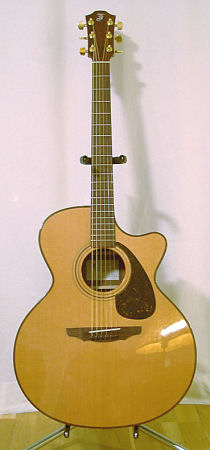
A superjumbo (no, there’s nothing wrong with your screen – it really is that big) steel-string acoustic built by Frantisek Furch in the Czech Republic, and sold to me by Leffe at 4Sound/Estrad Musik in Stockholm. At the time, it was the second simplest/cheapest model in the range – with acoustics I tend to gravitate towards the simpler and less fancy models, as they to my ears usually sound better. They often have thinner finishes, for instance, which I prefer. I like to have the guitar vibrate as freely as possible, and even if it’s only in my head, a really thin finish (so thin it’s barely there) helps it vibrate more naturally. A bonus to this ideology is that you don’t have to pay as much for the guitars – but that’s not the main reason… honestly…
This one has a solid cedar top, walnut purflings and rosewood back/sides/bridge. The neck is mahogany with a plain rosewood fingerboard. It also has an L.R. Baggs i-beam active pickup system – the most natural sounding pickup I’ve yet to hear. The only trouble is that the sound feels a smidge distant on the low strings. I suspect this isn’t the pickup’s fault, though – the Furch has a bridge plate that is easily three times as thick as normal (the bracings doesn’t go around it but straight across, and the areas in between are filled up with wood, to make up the bridge plate). This type of bridge plate/x-bracing design is part of the Furch sound, but it also increases the distance between the i-Beam pickup and the bridge. I suspect this is what causes the slightly lop-sided sound. I’m thinking about dropping the i-Beam altogether (installing it in the Seagull, where I suspect it will shine), and installing a UST/AST system from B-Band instead.
Any pickup installed in this guitar will need a parametric eq for live work, as it can get quite lively around 200 Hz. Other than that, all the i-Beam needs it a smidge less top (2-3 dB less at 12kHz) to sound fabulous. In fact, the pickup sounds so good on its own I’ve actually used it to record direct. And together with the Baggs Para Acoustic DI, the sound is superb. Not that it couldn’t ever be better, of course – ”perfect” is a constantly moving target.
Seagull S-series Grand
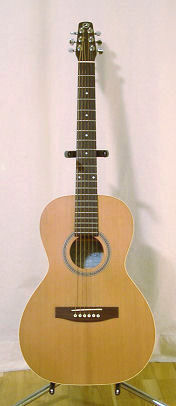
I got this guitar very cheaply from a friend of mine who used to run a music shop. When he closed the business, he asked me if I wanted to buy the guitar at cost – yet another offer I couldn’t refuse… 🙂
The small body makes it perfect for fingerpicking – the sound is very focused, and surprisingly big for its size. It has lots of the same qualities as a well played classical guitar – at least I hear it when my cousin plays it (as he knows how to properly play classical). Played with a pick, the sound is utterly crap. But stick to fingerpicking, and you will be rewarded. It records extremely well – before I bought the Grand, I found myself at times eq’ing the Furch to sound like this one. And again it’s a guitar on the cheaper end of the market that has caught me – the S-series are the most basic Seagulls around. But the features are all there: solid cedar top, wild cherry back+sides, maple neck with Indian rosewood fingerboard – what more do you want?
I’ve had the guitar for a good few years now, and it has loosened up very nicely indeed. The funny thing is that it seems to only get louder as the top matures. It already outpaces the Furch, which needs a heavy pick to keep up with fingerstyle playing on this one. And since the bridge plate is the standard (thin-ish) type, I suspect the Baggs i-Beam pickup would bring out the best of this guitar – I might just move it from the Furch. I would love to be able to bring this guitar to bigger gigs…
Parts bin
On a whim I came across a WD strat body with a flame maple top in honeyburst, and the race started… I quickly ordered a neck (telecaster, of course), Gotoh tuners and Gotoh/Wilkinson VS100 tremolo in Cosmo Black, black single layer pickguard etc. It may eventually become a ”nice” guitar (good for 2-piece suit gigs), with HSS pickup configuration, but I don’t know when that will happen.

I also have a second maple/maple Charvel neck (like the one on the Charvel/Warmoth) which may or may not come into play at some point. I initially intended to mate it with the Ibanez RG420 body – using a black original Floyd Rose bridge I have lying around – but since I found an original Ibanez neck for the 420, this neck is still in the ”parts” pile. I’ve looked into buying a Fender Blacktop Floyd Rose body for it, but haven’t gotten around to it. It’s not like I don’t already have any guitars…
